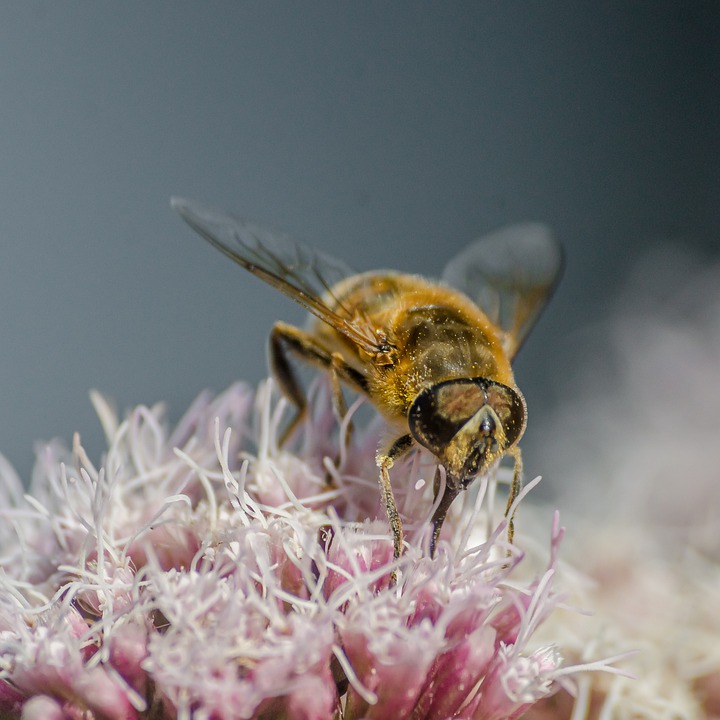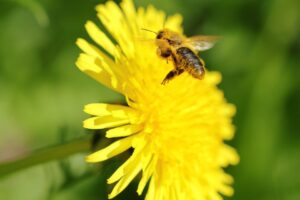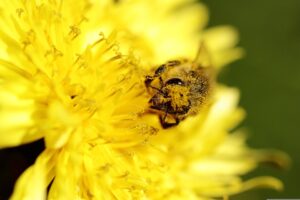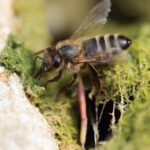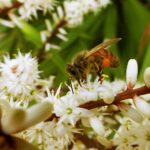In a previous chapter, we had a brief look at the need for suitable forage for bees and the value of placing your hives near such a source.
In this chapter, we look at what bees feed on and why they choose those foods. The honeybee’s basic nutritional requirements are like those of humans; namely, they need proteins (amino acids), carbohydrates (sugars), minerals, fats/lipids (fatty acids), vitamins, and water. To meet their nutritional requirements, honeybees collect nectar, pollen, and water.
Honeybees eat honey, which is processed nectar, and bee bread, which is processed pollen. The honey serves as a primary source of carbohydrates, which provides energy for flight, colony maintenance and general daily activities. Nectar, and thus honey, also provide minerals like calcium, copper, potassium, magnesium, and sodium, the presence and concentration of which depend on the source of nectar.
It is therefore very important that the colony has sufficient stores of honey for the winter months, for, without it, the colony will grow weaker and die.
Bees forage for water at almost any source close to their colonies. These sources include ponds, streams, leaky taps, the neighbour’s pool, dog dishes, and bird baths. During hot weather, honeybees use water to cool the colony by fanning and evaporating water droplets inside the hive. Water may also provide essential minerals in addition to hydration.
Bees forage mainly for nectar and pollen provided by flowering plants but also for resinous flowers of trees, and, if it is available, they also make use of honeydew. Bees collect any sweet substance, including sugar water, cool drinks, even overripe fruit, and proteins from animal feeds. “One can often see bees feeding on the fine pollen dust emanating from grain mills, and bags of mixed pig feed,” says Charles Salmon of the Western Cape Department of Agriculture.
It is important to keep in mind that bees forage with the sole purpose of feeding themselves to keep the swarm healthy and productive. Seasons come and go and in times of plenty, these industrious insects will work hard to collect as much feed as possible so that they can survive during lean times.
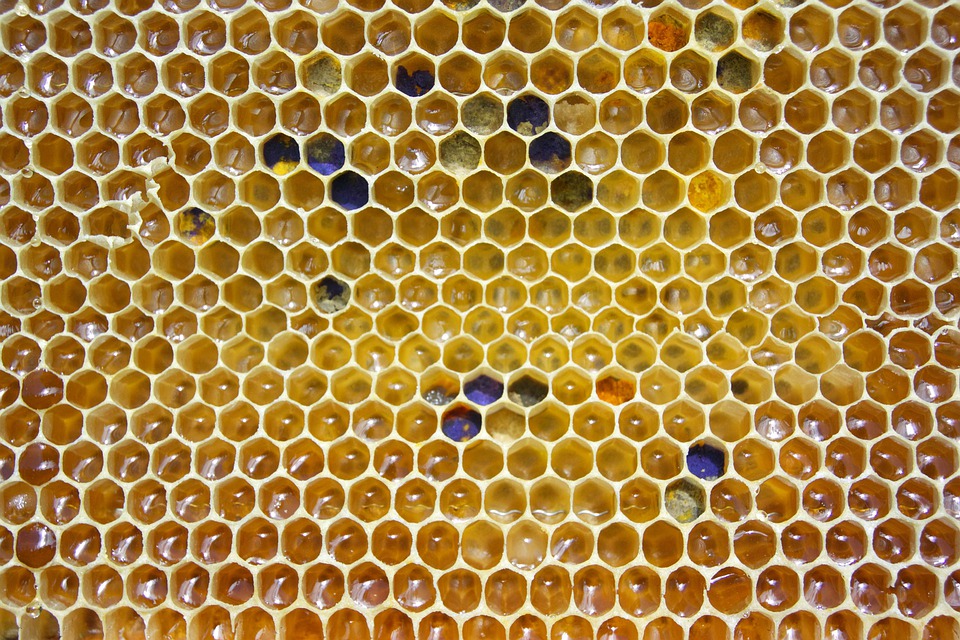
Wax cells filled with honey, which the bees produce from the nectar.
Products of the hive
The products of the hive give a good indication of why bees need specific food. Besides honey, other products found inside a hive include propolis, pollen and wax.
Honey is the primary product of a hive. The worker bee uses her long tongue to collect the flower’s nectar and store it in her nectar stomach. When she returns to the hive, she regurgitates the nectar and hands it over to a worker bee inside the hive. It is this second bee’s job to remove moisture from the nectar.
A physical process is used to remove most of the moisture, while a chemical process uses enzymes to change the sugar in the nectar to honey sugar.
The bee that receives the nectar from the returning worker bee moves to a part of the hive where there is air circulation. The bee regurgitates the nectar to the point of the tongue to expose it to air. She swallows it again and repeats the process with the next drop of regurgitated honey. This continues until the moisture content is reduced from 60 to 80% to 16 tot 20% before she deposits it into a cell on the honeycomb. If the moisture is not removed, the nectar will ferment and rot.
Bees whose job is to ventilate the hive by whirring their wings, circulate dry air in the hive to continue the evaporation process. Raw nectar consists of three sugars: sucrose, glucose, and fructose. As the process nears its end, the honey is deposited into empty wax cells and covered with a layer of wax to store the honey.
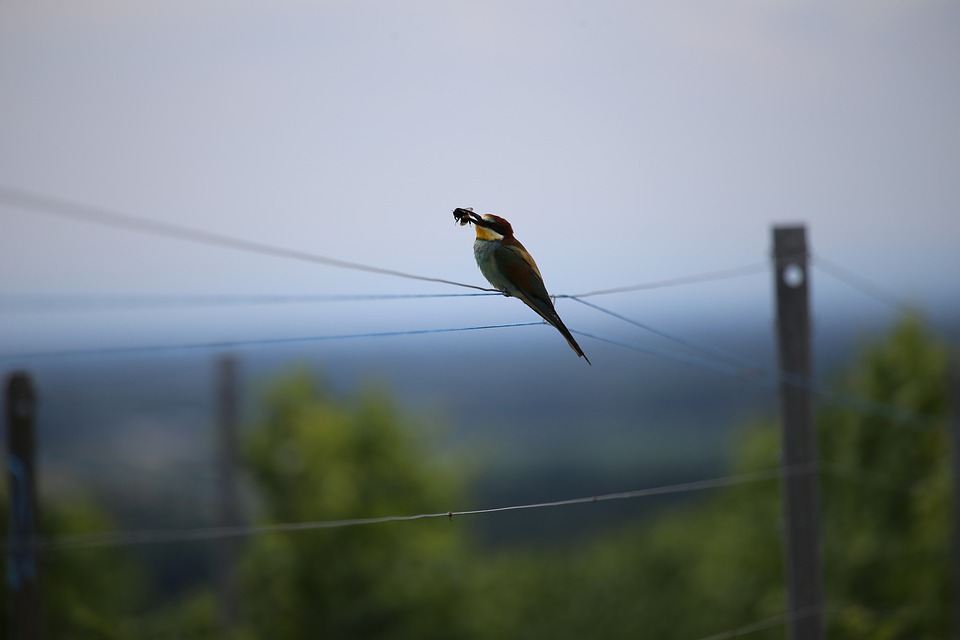
The queen bee, here marked with a V, is fed royal jelly, which is produced by the worker bees.
Pollen is the male reproductive unit of plants and is essential for pollination. Bees do not produce pollen but collect it from plants and store it in honeycomb cells. By mixing it with honey, the pollen is preserved so that it is available for the bees to feed on. Humans use pollen in some medicines and cosmetics.
Propolis is the third most important component of bee products. It is composed mainly of resin (50%), wax (30%), essential oils (10%), pollen (5%) and other organic compounds (5%).
It is a resin-like material made by bees which are collected from different plants like fynbos, the buds of poplar and cone-bearing trees. The bees use it to protect their nest against disease and pests; by repairing holes in the hives, they protect it against rain and wind. Propolis has antibiotic properties, and it is used for medicinal purposes. Wax flakes are excreted by young worker bees. The bees chew, shape and use the wax to build the cells of the honeycomb. New wax is white in colour, but it turns darker when it is in contact with the brood. When the larva outgrows the cell, it leaves behind its skin in the wax cell filled with honey, pollen or propolis.
“The colour of pollen differs greatly and is not always bright yellow. An aloe species provides orange-red pollen,” says Charles. Some beekeepers believe that different colours of pollen in a hive are an indication of a variety of feed plants, which is ideal.
Humans use wax for the manufacture of candles, cosmetics, food processing, polish, and medicine, among other things.
Bees use their poison to protect themselves. The poison is manufactured in bees between three- and 21 days old. It has medicinal value and is used as a medication for rheumatism.
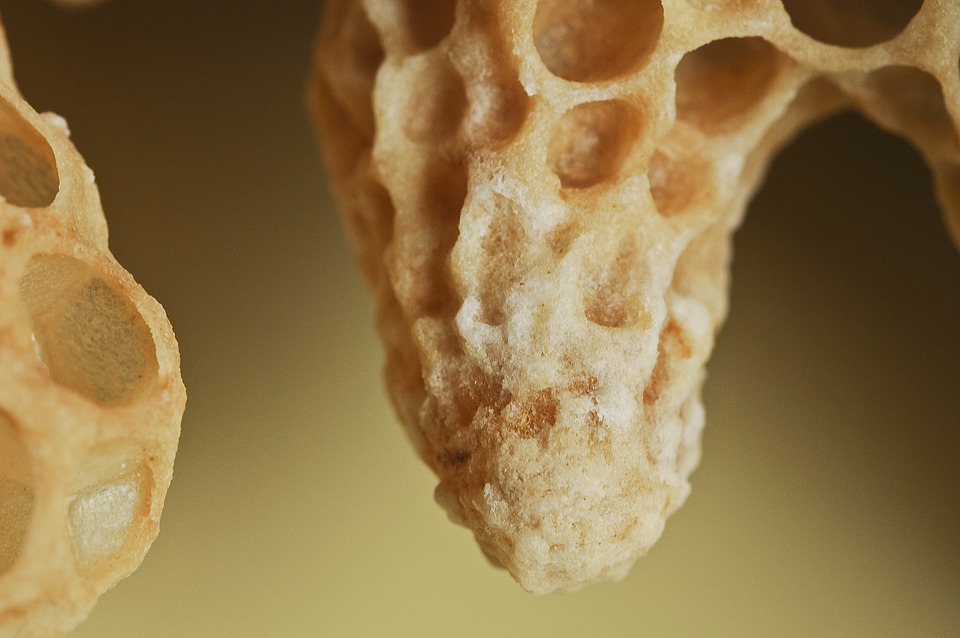
The queen bee cells differ from ordinary cells in which eggs are laid.
Royal jelly
Royal jelly is a white and viscous jelly-like substance secreted by worker bees. It is a superfood that is consumed by the queen bee, which probably contributes to her living much longer than other bees. It is also fed to immature young larvae in their first two to three days of maturation. Royalactin is the main compound in the royal jelly, which allows the morphological change of a larva into a queen bee.
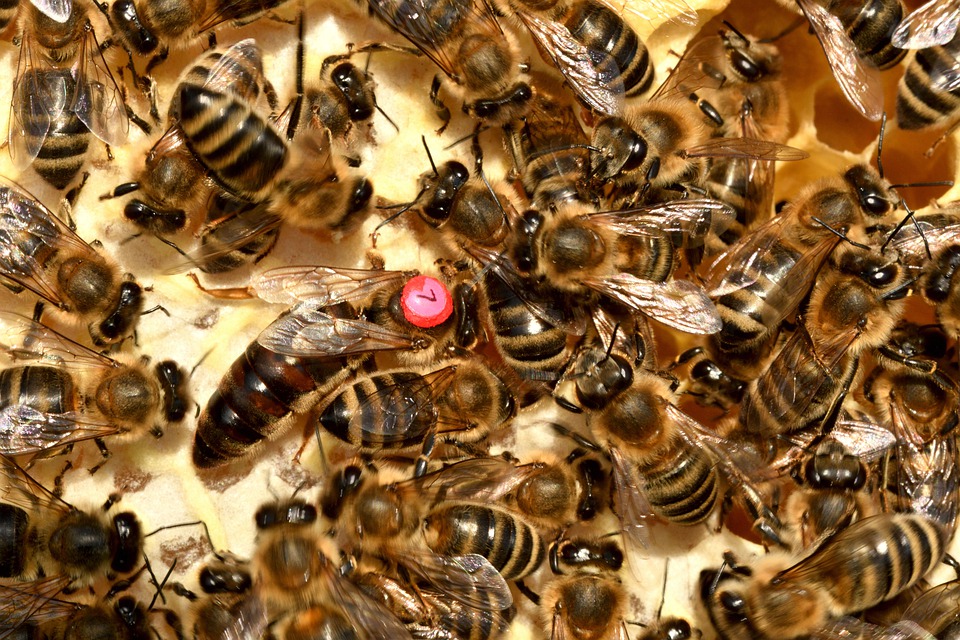
The queen bee, here marked with a V, is fed royal jelly, which is produced by the worker bees.
What is nectar?
Where does nectar come from, what does it consist of and why is it important for the bees?
Nectar is a sugar-rich liquid that is produced by plants’ nectar glands, called nectaries. These glands can be situated inside the flower, or on the leaves or stem, also called extrafloral nectaries. These provide a nutrient source to animal mutualists, such as ants, which in turn provide protection against herbivores. ‘A nectary is a floral tissue that can be in different parts of the flower. It is one of the different secretary glands that produce nectar, oil, or scent.
The function of these glands is to attract possible pollinators, such as bees, wasps, butterflies, moths, and mosquitos, as well as birds such as hummingbirds, honeyeaters and even bats.
Once a pollinator has visited the flower, the leftover nectar can be reabsorbed into the plant. Several factors influence the production of nectar, such as the age of the flowers, the location of the plant, whether the honeybee can reach the nectar, as well as the management of the habitat, such as enough water. According to Charles, the soil type, such as the lime content, also contributes to good honey production.
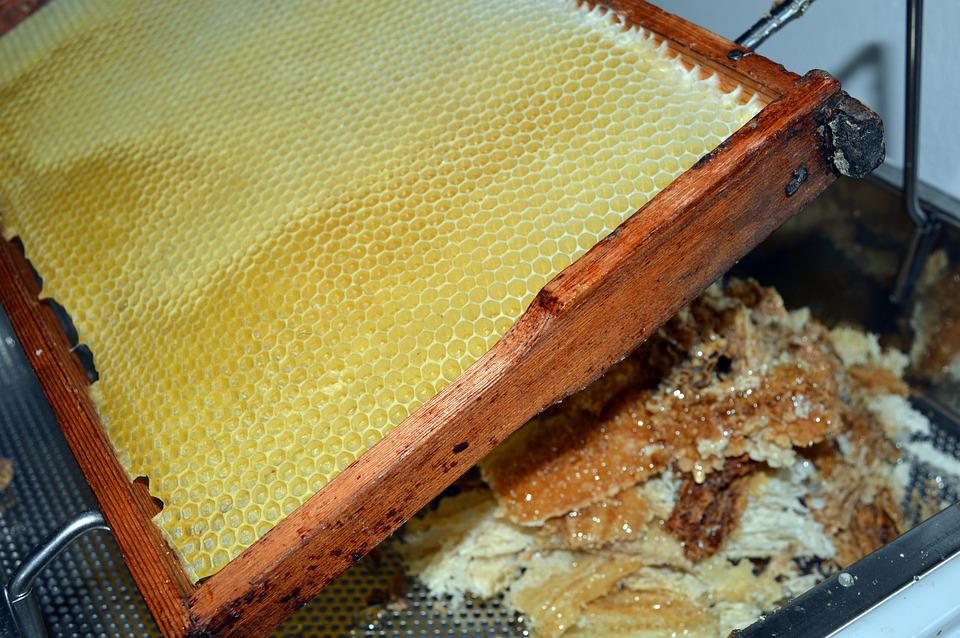
Wax is a product of the hive.
What is pollen?
Pollen is a powdery substance produced by male plants. The pollen grains produce male sperm cells. When a sperm cell comes into touch with a female plant’s stigma, it moves down the style to the ovary, where they germinate.
Pollen in the form of bee bread is the honeybee’s main source of protein, while it also provides fats, minerals, and vitamins. The protein is important for brood production and the development of young bees.
Pollen consists of water, ether extract, carbohydrates, including reducing sugars, non-reducing sugars, starch, lipids, ash, and some other contents. Because not all pollens are equally nutritious to bees, they need different sources of flowers to provide all the components.
Honeybees apparently choose pollen based on the odour, shape, and size of the pollen grains. A colony with a typical size of about 20 000 bees, collects about 57 kg of pollen per year. Between 15 and 30% of the colony’s foragers collect pollen and a single bee can bring back a pollen load of about 35% of the bee’s weight in the pollen baskets on its hind legs.
Once the pollen has been brought to the hive, the workers condition it by adding glandular secretions that contain enzymes and acids. These secretions prevent harmful bacterial activity so that
the pollen can be stored as bee bread.
- Bees collect pollen from pollen-bearing flowers for protein-rich feed.
- Pollen is collected in ‘pollen baskets’ on the hind legs, but also on the hairy body.
The bees also add beneficial microbes to the pollen and produce enzymes that help the pollen release nutrients and amino acids, the building blocks of protein.
The colony consumes the bee bread relatively quickly and it is only stored for a couple of months, and only if there is a surplus. The colony requires about 15 to 55 kg of pollen per year. They use pollen for growth and development. Immature bees are fed a mixture of brood food and bee bread. Newly emerged bees eat bee bread to help their bodies reach maturity and the requirement of a single worker larva is about 124 to 145 mg, which contains about 30 g of protein. Pollen with a high protein content helps to grow strong and healthy worker bees that live longer, which is needed to grow a strong colony.
Ensuring bee nutrition
A beekeeper must make sure that the plants in the area have enough nectar and pollen to provide the bees with food. Plants that produce a lot of nectar, do not necessarily produce pollen for bees. It is important that bees have a large variety of plants to collect nectar and pollen from because no single pollen provides all the nutrition honeybees need. Just like humans, bees need a well-rounded diet, and the quality of the pollen is more important than the quantity.
The colony’s needs change according to the season and brood production. If there is a lack of pollen or the beekeeper thinks that the pollen is of poor quality, it is necessary to provide a pollen substitute or supplement.
In the next chapter, we will look at the additional feed to keep your bees healthy in lean times, such as winter.
- A bee sucks moisture from a lichen. Besides nectar and pollen, bees also need water.
- Bees sometimes ‘accidentally’ collect pollen while they take nectar from flowers, but sometimes bees collect only pollen or nectar.
For more information contact Charles Salmon, Western Cape Department of Agriculture, at Charles.Salmon@westerncape.gov.za or 082-651-7466
References
Burger, P. Die heuningby: Handleiding vir die saadprodusent. Klein Karoo Saadproduksie (Edms) Bpk, Oudtshoorn https://www.seedproduction.co.za/wp-content/uploads/2015/10/Bye_Handleiding.pdf
Ellis, A., Ellis, J.D., O’Malley, M.K., Zellen Nalen, C.M. (2020) The benefits of pollen to honey bees. The Institute of Food and Agricultural Sciences (IFAS). https://edis.ifas.ufl.edu/pdf/IN/IN86800.pdf
Nectar (2022) Wikipedia https://en.wikipedia.org/wiki/Nectar
Pasupuleti, V.R., Sammugam, L., Ramesh, N., Gan, S.H. Honey, Propolis, and Royal Jelly: A Comprehensive Review of Their Biological Actions and Health Benefits. Oxid Med Cell Longev. 2017;2017:1259510. doi: 10.1155/2017/1259510. Epub 2017 Jul 26. PMID: 28814983; PMCID: PMC5549483. https://pubmed.ncbi.nlm.nih.gov/28814983/
Propolis – Uses, side effects, and more (n.d) WebMD. https://www.webmd.com/vitamins/ai/ingredientmono-390/propolis
Propolis (2022) Wikipedia https://en.wikipedia.org/wiki/Propolis

